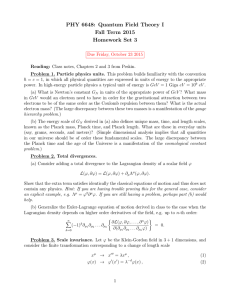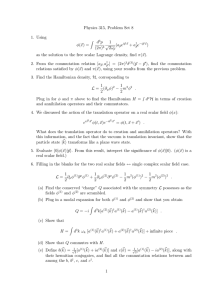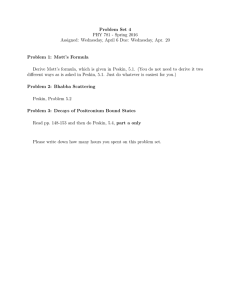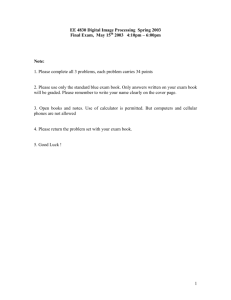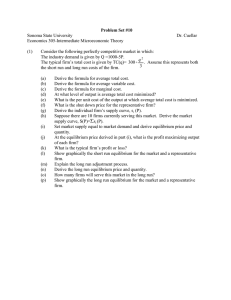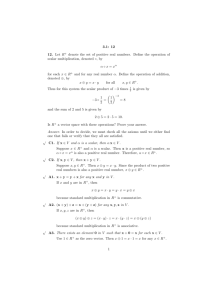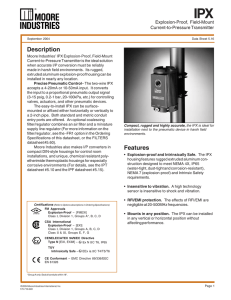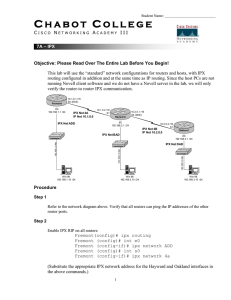PHY 6648: Quantum Field Theory I Fall Term 2005 Homework Set 4
advertisement
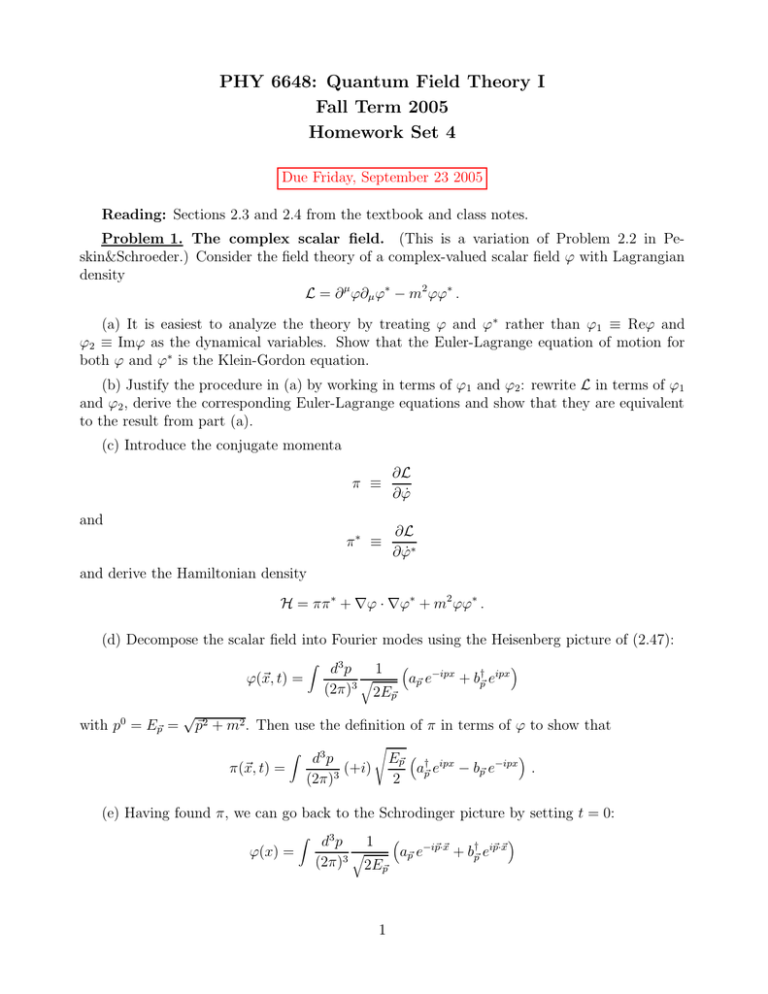
PHY 6648: Quantum Field Theory I Fall Term 2005 Homework Set 4 Due Friday, September 23 2005 Reading: Sections 2.3 and 2.4 from the textbook and class notes. Problem 1. The complex scalar field. (This is a variation of Problem 2.2 in Peskin&Schroeder.) Consider the field theory of a complex-valued scalar field ϕ with Lagrangian density L = ∂ µ ϕ∂µ ϕ∗ − m2 ϕϕ∗ . (a) It is easiest to analyze the theory by treating ϕ and ϕ∗ rather than ϕ1 ≡ Reϕ and ϕ2 ≡ Imϕ as the dynamical variables. Show that the Euler-Lagrange equation of motion for both ϕ and ϕ∗ is the Klein-Gordon equation. (b) Justify the procedure in (a) by working in terms of ϕ1 and ϕ2 : rewrite L in terms of ϕ1 and ϕ2 , derive the corresponding Euler-Lagrange equations and show that they are equivalent to the result from part (a). (c) Introduce the conjugate momenta π ≡ ∂L ∂ ϕ̇ π∗ ≡ ∂L ∂ ϕ̇∗ and and derive the Hamiltonian density H = ππ ∗ + ∇ϕ · ∇ϕ∗ + m2 ϕϕ∗ . (d) Decompose the scalar field into Fourier modes using the Heisenberg picture of (2.47): ϕ(~x, t) = with p0 = Ep~ = Z 1 d3 p † ipx −ipx q a e + b e p ~ p ~ (2π)3 2Ep~ √ 2 p~ + m2 . Then use the definition of π in terms of ϕ to show that π(~x, t) = d3 p (+i) (2π)3 Z s Ep~ † ipx ap~ e − bp~ e−ipx . 2 (e) Having found π, we can go back to the Schrodinger picture by setting t = 0: ϕ(x) = Z d3 p 1 † i~ p·~ x −i~ p·~ x q e a e + b p ~ p ~ (2π)3 2Ep~ 1 π(x) = Z d3 p (+i) (2π)3 s Ep~ † i~p·~x ap~ e − bp~ e−i~p·~x . 2 Quantize the field by imposing the usual commutation relations h [ϕ(~x), π(~y)] = iδ (3) (~x − ~y ), h i i ϕ† (~x), π † (~y) = iδ (3) (~x − ~y ), h i [ϕ(~x), ϕ(~y)] = ϕ† (~x), ϕ† (~y) = [π(~x), π(~y)] = π † (~x), π † (~y ) = 0, h i h i h i h i ϕ(~x), ϕ† (~y ) = ϕ(~x), π † (~y ) = π(~x), ϕ† (~y ) = π(~x), π † (~y) = 0 . Show that these are satisfied if h i h p − ~q), ap~ , aq†~ = (2π)3 δ (3) (~ i p − q~) bp~ , bq†~ = (2π)3 δ (3) (~ and all other commutators involving a’s and/or b’s vanish. (f) Derive the Hamiltonian operator H= Z d3 p † † E a a + b b . p ~ p ~ p ~ p ~ p ~ (2π)3 Would there have been any difference if we started with π ∗ π instead of ππ ∗ ? (g) Derive the total three-momentum operator P~ for the complex scalar field (as in Problem 1 of HW Set 3). (h) Show that the quantized complex scalar field describes two sets of particles with mass m. (i) At this point, the a and b particles look indistinguishable. Recall that there is a conserved charge in this theory due to invariance under phase rotations (see Eq. (2.15)). Derive the conserved charge in the classical theory and show that in the quantized theory it is given by the relative number of a and b particles: Q=± Z d3 p † † a a − b b . p ~ p ~ p ~ p ~ (2π)3 If we identify this with the electric charge, this implies that a† and b† create states of the same mass m, but opposite charge, i.e. particles and antiparticles. What determines the overall sign of Q? (j) (optional) Part (d) of Peskin&Schroeder Problem 2.2. 2
